Advanced Solutions of Microsoft SharePoint Server 2013 v12.0
Question 1
You need to configure the site collection upgrade settings.
Which Windows PowerShell cmdlets should you run?
- A. $site = Get-SPSite https://teams.proseware.com/productdev/marketing and Ssite.UpgradeReminderDelay = 0 and $site.UpgradeMaintenanceLink = $n
- B. $site = Get-SPSite https://teams.proseware.com/productdev/marketing and $site.AllowSelfServiceUpgrade = $false
- C. Ssite = Get-SPSite https://teams.proseware.com/productdev/marketing and $site.AllowSelfServiceUpgrade = $true
- D. $site = Get-SPSite https://teams.proseware.com/productdev/research and $site.AllowSelfServiceUpgrade = $false
- E. $site = Get-SPSite https://teams.proseware.com/productdev/research and Ssite.AllowSelfServiceUpgrade = $true
Answer : B
Question 2
You are preparing to migrate to the new SharePoint environment.
You need to configure SQL Server connectivity.
What should you do?
- A. Configure a SQL Server client alias.
- B. Configure a CNAME alias for SQL1.
- C. Configure Request Management and specify a routing rule for database connections.
- D. Configure a SQL Server failover cluster.
Answer : A
Question 3
You are preparing to create the ProductsKB site.
You need to create and configure the ProductsKB site to store product images.
Which four actions should you perform in sequence? (To answer, move the appropriate actions from the list of actions to the answer area and arrange them in the correct order.)
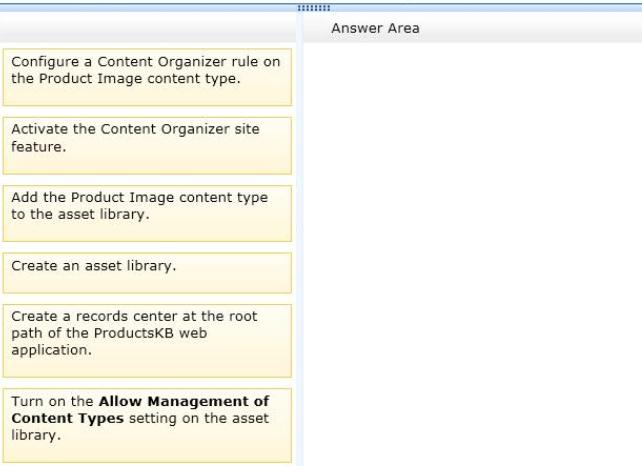
Answer : 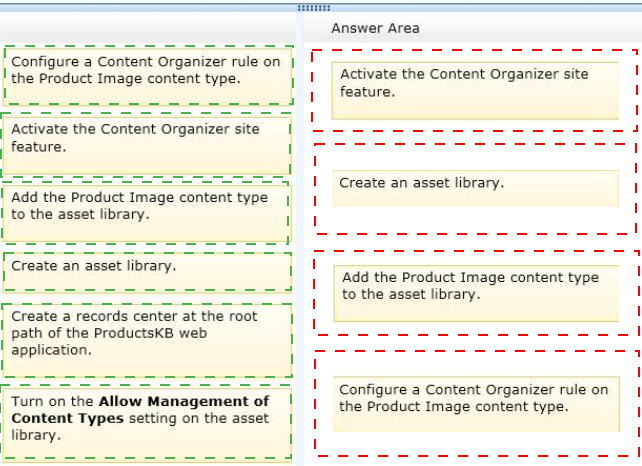
Explanation:
Box 1: Activate the Content Organizer site feature.
Box 2: Create an asset library.
Box 3: Add the Product Image content type to the asset library.
Box 4: Configure a Content Organizer rule on the Product Image content type.
Note:
* The Content Organizer is a SharePoint feature that can automatically manage some important library tasks. This not only saves time, but can help make sure that a document library is managed consistently.
* The Content Organizer can automatically do the following tasks:
/ Route documents to different libraries or folders In effect, the Content Organizer acts as a gatekeeper for documents. Each time that a document is uploaded, the Content Organizer uses rules that you created to determine where it should move the document. Then, it routes the document to the correct library or folder, which can be located in a different site collection. Rules can be based on a combination of content types and metadata.
/ More tasks. Not listed here.
* To determine how to route a document, Content Organizer uses rules that you create.
Rules are based on a combination of content types and metadata.
* Before you create rules: First steps
There are several important steps that you have to follow before you create rules for routing documents.
1. Activate the Content Organizer feature.
2. Create libraries and folders that you want documents to be routed to. You might want to create folders for each type of document that you are routing. For example, create a library just for e-mail records or Excel spreadsheets. To learn about how to create libraries, see the links in the See Also section.
3. Content types must be associated with documents that are to be routed. In them, the content type can be part of the criteria that determines the final location where a document is stored.
* Create rules to route documents
For each record type that you add to the Record Routing list, you specify a record title and description. You also specify the location in the site where the record is stored. To make sure that all relevant records are routed to the appropriate location, you can specify alternate names for the record type.
-> Navigate to the site for which you want to create Content Organizer rules.
-> On the Quick Launch panel, click More… to see the Site Contents options.
-> From the Apps menu line, click Settings.
4.On the Site Settings page, under the Site Administration section, click Content Organizer
Rules.
Etc.
Question 4
You are planning for high availability of the SharePoint environment.
You need to plan the Request Manager configuration.
How should you configure Request Manager? (To answer, drag the appropriate elements to the correct positions in the answer area. Each element may be used once, more than once, or not at all. You may need to drag the split bar between panes or scroll to view content.)
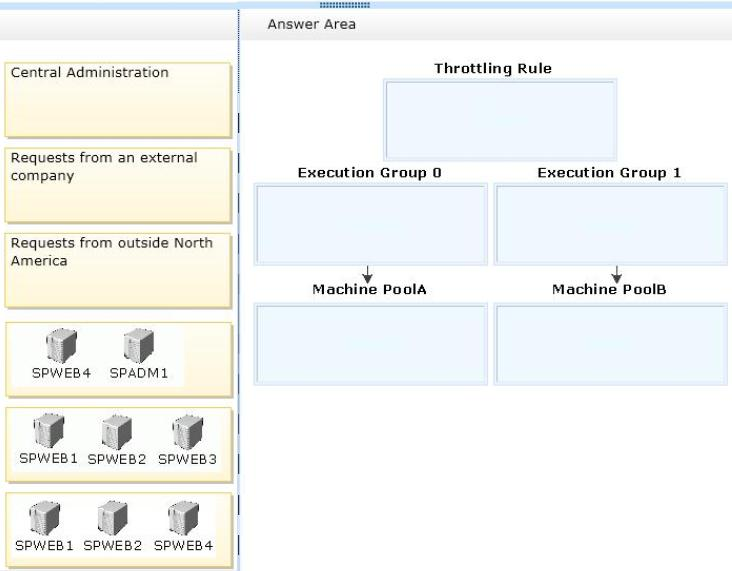
Answer : 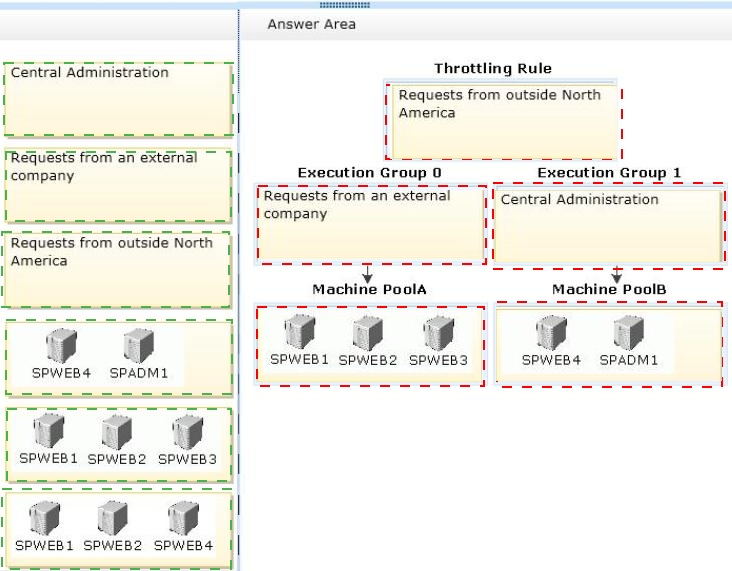
Explanation:
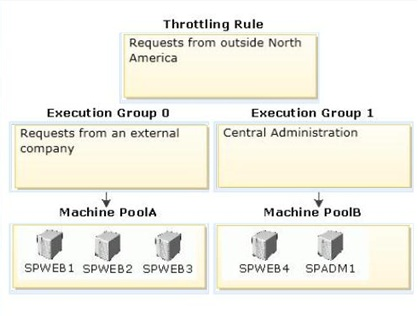
Note:
* From scenario:
/ Due to export and copyright restrictions, SharePoint sites may be accessed only from within North America
Here implemented through the Throttling Rule.
/ Requests originating from outside the company network must not be routed to any server running Central Administration.
/ Central Administration has been provisioned on SPWEB4 and SPADM1.
Here available only for Execution Group 1.
* Throttling Rules
A Throttling Rule is the definition of the criteria to evaluate before refusing requests which match the criteria. Throttling Rules are NOT associated with a Machine Pool or an
Execution Group. Throttling Rules can have an expiry time set.
* Execution Groups
A Execution Group is a collection of Routing Rules which allows the precedence of rule evaluation to be controlled and Routing Rules to be managed in batches. There are three execution groups (0, 1 & 2) which are evaluated in order. If no Execution Group for a
Routing Rule is specified it is associated with Execution Group 0.
* SharePoint Server 2013 introduces a new capability called Request Management.
Request Management allows SharePoint to understand more about, and control the handling of, incoming requests. Request Management employs a rules based approach, which enables SharePoint to take the appropriate action for a given request based upon administrator supplied configuration.
Question 5
You are configuring the ProseWeb site.
You need to create the root site collection on the web application.
Which three actions should you perform in sequence? (To answer, move the appropriate actions from the list of actions to the answer area and arrange them in the correct order.)
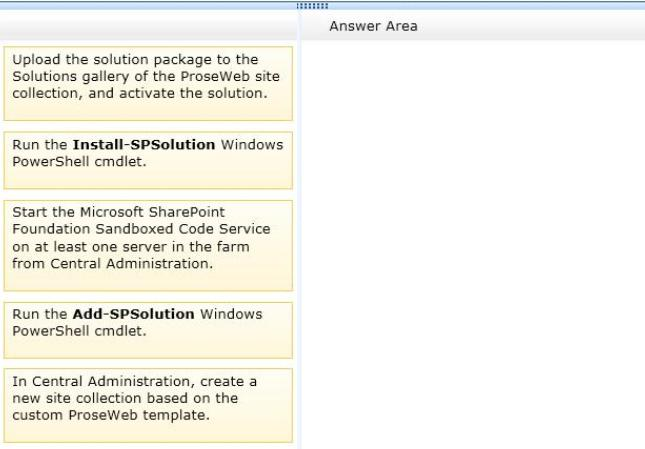
Answer : 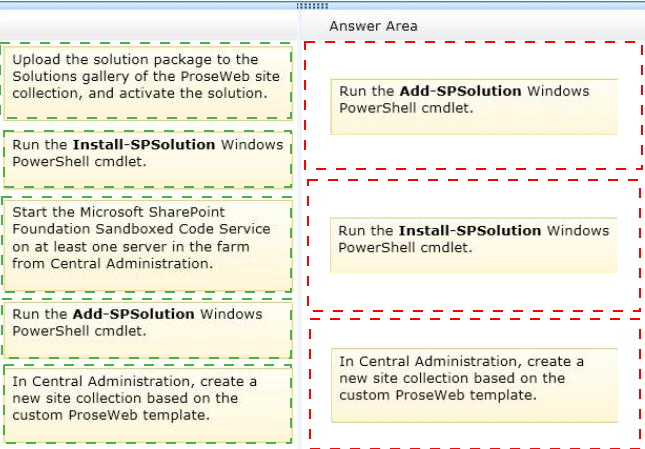
Explanation:
Box 1:

Box 2:

Box 3:

Note:
* Add-SPSolution uploads a SharePoint solution package to the farm.
* The Install-SPSolutioncmdlet deploys an installed SharePoint solution in the farm. Use the Add-SPSolutioncmdlet to install a SharePoint solution package in the farm.
Question 6
You need to configure the Send To connection.
Which URL should you specify?
- A. https://kb.proseware.com/dropofflibrary
- B. https://kb.proseware.com/_vti_bin/officialfile.asmx
- C. https://teams.proseware.com/_vti_bin/copy.asmx
- D. https://teams.proseware.com/_vti_bin/officialfile.asmx
Answer : B
Explanation: * From scenario:
/ The ProductsKB site must be provisioned by using a Records Center site template.
/ ProductsKB - https://kb.proseware.com
* We should append _vti_bin/officialfile.asmx as a default to the URL.
Reference: SharePoint 2010 Document Center Send To Connection Setup Walkthrough
Topic 5, Contoso Ltd -
Background -
A company named Contoso, Ltd. has offices in Seattle and Toronto. Each office has a data center and a region-specific site in a single Active Directory Domain Services (AD DS) domain named contoso.com. The database servers run Microsoft SQL Server 2008 R2.
Database servers are installed in each data center and are members of the region-specific sites. The WAN connection between the data centers is a dedicated T3 connection.
Existing Corporate Farm -
Contoso has a SharePoint farm named HQ-SP10. The SharePoint servers in the farm run
SharePoint Server 2010 on Windows Server 2008 R2.
HQ-SP10 hosts many web applications that require unique service accounts. A SharePoint
2010 web application named WebApp1 is located at https://webapp1.contoso.com.
WebApp1 references a custom knowledge base module in HQ-SP10 and the content is stored in the SharePoint database HQDB. Employees authenticate to WebApp1 by using classic mode authentication.
Users in both offices make frequent updates to SharePoint content. Administrators make only minimal changes to the SharePoint farm settings and web applications.
Existing Product Support Farm -
The product support department hosts a SharePoint farm named DEPT-SP13. The
SharePoint servers in the farm run SharePoint Server 2013 and are members of a domain named PrdSupport.contoso.com.
DEPT-SP13 hosts two service applications:
-> A built-in service application provides access to a business data model connected to the company's data warehouse.
-> A custom service application named SvcApp1 provides access to data in a legacy system.
Users in the product support department access the service applications by using a local web application named WebApp2. WebApp2 is located at webapp2.contoso.com and is stored in the SharePoint database DEPTDB. Users in other departments access the service applications by using WebApp1.
Technical Challenges -
You are upgrading HQ-SP10 and the web applications hosted in the farm to a new
SharePoint Server 2013 farm named HQ-SP13.
When upgrading the content database to SharePoint Server 2013, you receive the following error message:

Business Requirements -
The SharePoint 2010 environment must meet the following business requirements:
-> HQ-SP10 must provide read-only access to users during the migration.
-> All customizations in HQ-SP10 must be migrated to HQ-SP13.
The SharePoint 2013 environment must meet the following business requirements:
-> HQ-SP13 and the web applications must remain available if one of the SharePoint servers or database servers is offline.
-> Users' documents stored in HQ-SP13 must be available if all the serv
Question 7
You need to configure the required level of access to the SharePoint 2010 farm prior to the migration.
What should you do?
- A. In the corporate farm, run the ALTER DATABASE Transact-SQL statement.
- B. In the corporate farm, run the CONFIG DATABASE Transact-SQL statement.
- C. In the product support farm, run the CONFIG DATABASE Transact-SQL statement.
- D. In the product support farm, run the ALTER DATABASE Transact-SQL statement.
Answer : A
Question 8
You are configuring service applications to support access to the company data warehouse.
You need to assign permissions.
Which two service applications should you configure? (To answer, select the appropriate service applications in the answer area.)
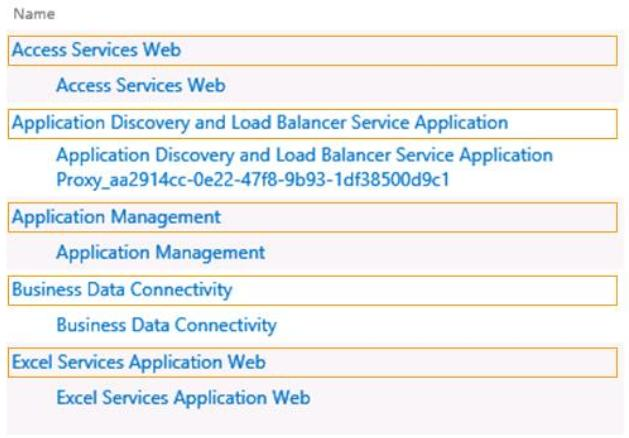
Answer : 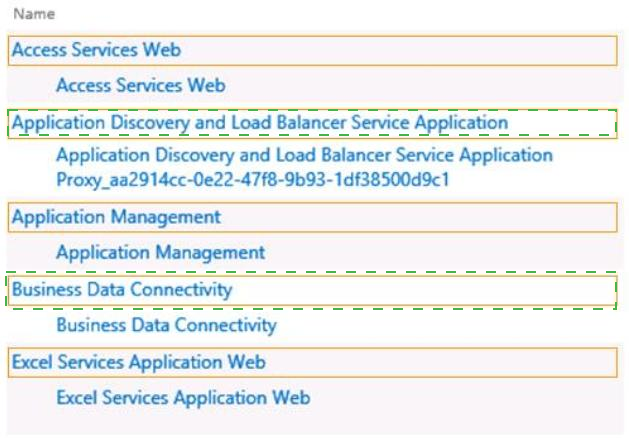
Explanation:
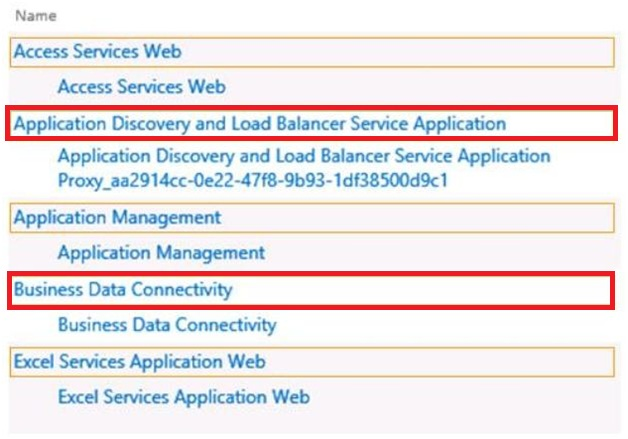
Note:
Application Discovery and Load Balancer Service Application
Business Data Connectivity -
* From scenario:
/ DEPT-SP13 hosts two service applications:
-> A built-in service application provides access to a business data model connected to the company's data warehouse.
Question 9
You need to configure the database servers for high availability.
What should you do? (To answer, drag the appropriate elements to the correct target or targets in the answer area. Each element may be used once, more than once, or not at all.
You may need to drag the split bar between panes or scroll to view content.)
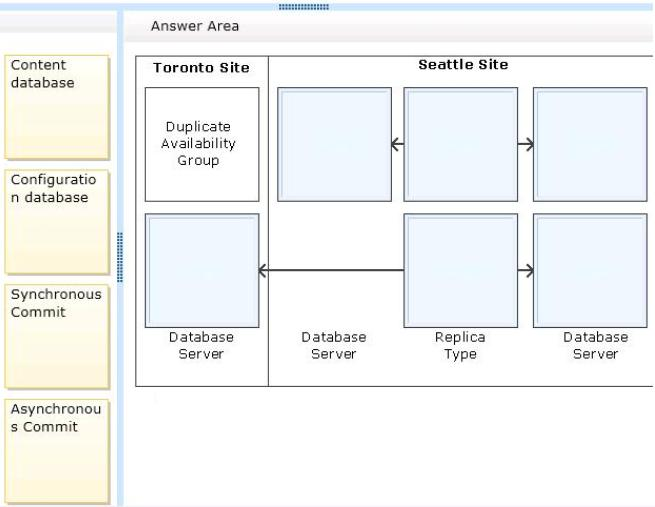
Answer : 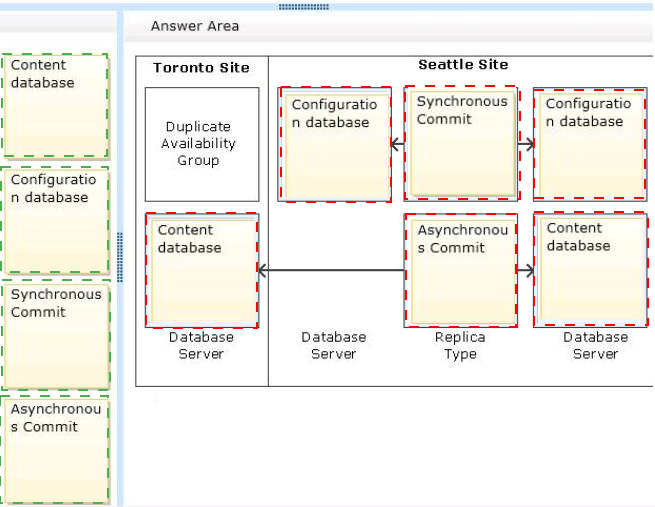
Explanation:
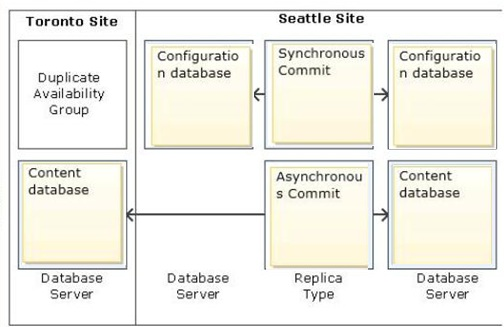
Note:
* The content database should be placed on the database servers.
* The configuration database can replicated synchronously locally on the Seattle site.
* From scenario:
/ The databases must belong to a SQL Server AlwaysOn Availability Group and use the
WAN connection for database replication between the sites.
This implies an Asynchronous commit Commit Replica Type.
Question 10
You need to configure authentication for the WebApp1 application pool account.
What should you do?
- A. Add the application pool account to the db_owner fixed database role in the Master database.
- B. Add the application pool account to a contained database.
- C. Copy the application pool account from the primary replica databases to the secondary replica databases.
- D. Re-create the application pool account in SharePoint Server 2013.
Answer : B
Question 11
You need to choose a backup solution.
Which solution should you choose?
- A. SharePoint backup from the Central Administration console
- B. SQL Server backup by using SQL Server Management Studio
- C. Windows Server Backup in Windows Server 2012
- D. SharePoint backup by using Data Protection Manager (DPM)
Answer : A
Question 12
Before you upgrade the web application, you need to validate that customizations will continue to function.
Which Windows PowerShell cmdlet should you run?
- A. Test-SPSite -Identity http://webapp1.contoso.com
- B. Test-SPContentDatabase -Identity HQDB -WebApplication http://webapp1.contoso.com
- C. Test-SPSite -Identity http://webapp2.contoso.com
- D. Test-SPContentDatabase -Identity DEPTDB -WebApplication http:// webapp2.contoso.com
- E. Get-SPUpgradeActions -AssignmentCollectionspweb
Answer : B
Question 13
You need to resolve the SharePoint database error.
What should you do?
- A. Add a new request URL mapping to the web application.
- B. Remove the orphaned objects from the database.
- C. Set the databases to read-write.
- D. Add the managed path for the site collection to the web application.
Answer : D
Explanation:
-> ERROR Template Template Id: SPSite Id=Site Id could not be accessed due to exception. Skipping SPWeb Id=Web Id for template upgrade. Exception:
System.IO.FileNotFoundException: The site with the id Site Id could not be found.
This error indicates that a managed path is missing. Add the managed path for the site collection into the web application and restart upgrade for the content database that contains this site collection.
Ref: http://technet.microsoft.com/en-us/library/cc262967(v=office.15).aspx
Question 14
You need to ensure that users can edit the appropriate documents by using Office Web
Apps.
Which Windows PowerShell cmdlet should you run?
- A. Set-SPWebApplication -Identity "https://webapp2.contoso.com" - AdditionalClaimProvider Force
- B. Set-SPWebApplication -Identity "https://webapp1.contoso.com" - AdditionalClaimProvider Force
- C. Convert-SPWebApplication -Identity "https://webapp2.contoso.com" -To Claims -Retain Permissions
- D. Convert-SPWebApplication -Identity "https://webapp1.contoso.com" -To Claims -Retain Permissions
Answer : D
Question 15
You need to make the required resources available for users in the accounting department.
Which four actions should you perform in sequence? (To answer, move the appropriate actions from the list of actions to the answer area and arrange them in the correct order.)
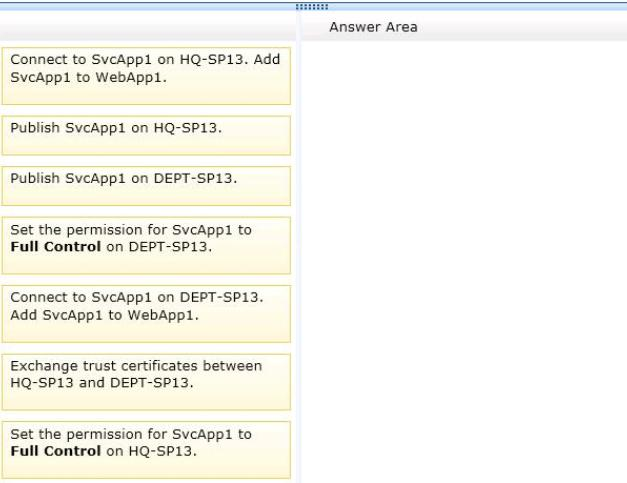
Answer : 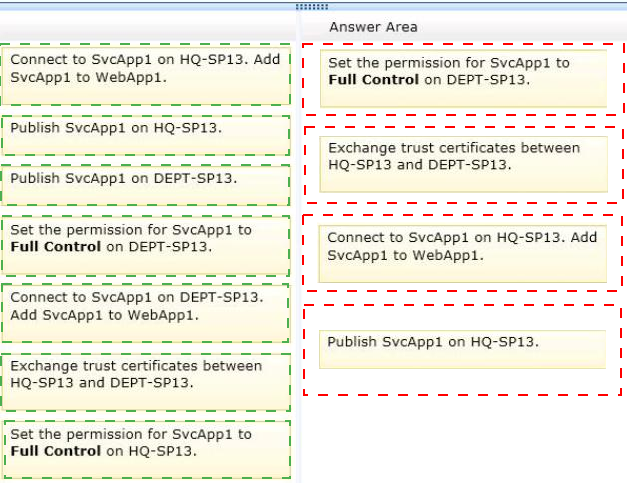
Explanation:
Box 1: Set the permission for SvcApp1 to full Control on DEPT-Sp13.
Box 2: Exchange trust certificates between HQ-Sp13 and DEPT-Sp13.
Box 3: Connect to SvcApp1 on HQ-SP13. Add SvcApp1 to WebApp1.
Box 4: Publish SvcApp1 on HQ-Sp13.
Note:
* From scenario:
/ After the upgrade, users in the accounting department who connect to WebApp1 must be able to access shared resources in SvcApp1
/ A custom service application named SvcApp1 provides access to data in a legacy system.
/ Shared resources in SvcApp1 must be available to other SharePoint farms in the company.
/ HQ-SP10 hosts many web applications that require unique service accounts. A
SharePoint 2010 web application named WebApp1 is located at
https://webappl.contoso.com. WebApp1 references a custom knowledge base module in
HQ-SP10 and the content is stored in the SharePoint database HQDB. Employees authenticate to WebApp1 by using classic mode authentication.
/ DEPT-Sp13 is the old server. HQ-Sp13 is the new server.
/ Current scenario:
DEPT-SP13 hosts two service applications:
A built-in service application provides access to a business data model connected to the company's data warehouse.
A custom service application named SvcApp1 provides access to data in a legacy system.